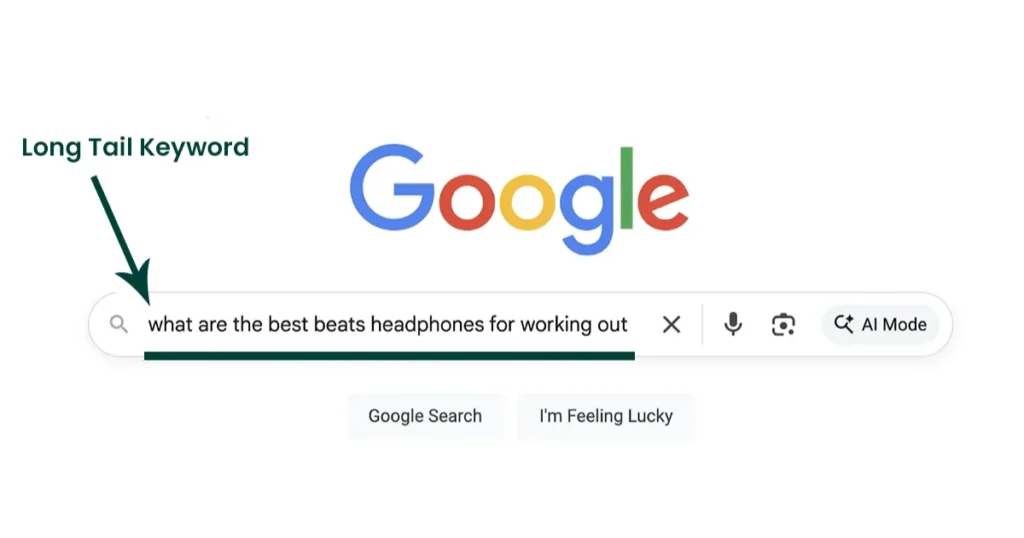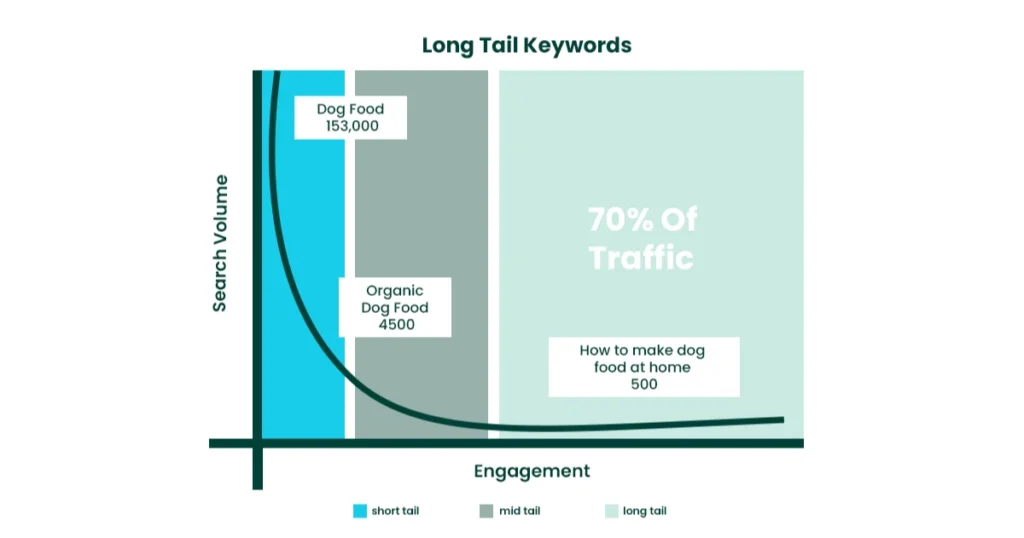In the competitive world of digital marketing, businesses are constantly searching for ways to stand out in search results and attract the right audience. One of the most effective yet underutilized strategies is targeting long tail keywords. These are longer, highly specific search phrases that reflect user intent more clearly than broad, generic terms. They may not always bring massive traffic individually, but together, they account for most searches on Google and often bring in users who are ready to take action.
Research shows that over 92% of all search queries are long tail keywords (Ahrefs). This means that if you’re not targeting them, you’re missing out on a huge pool of potential traffic. Unlike short keywords that are highly competitive, long tail keywords give small and mid-sized businesses an edge by providing a realistic path to rank higher, attract targeted visitors, and improve conversions. With the right SEO services, such as keyword research, content optimization, and competitor analysis, businesses can uncover profitable long tail opportunities and turn them into consistent streams of organic traffic.
What Are Long Tail Keywords?

Long tail keywords are extended keyword phrases that are more descriptive and specific than general search terms. For instance, instead of “shoes,” someone might search for “best running shoes for flat feet women 2025.” These longer searches capture exactly what users are looking for and allow websites to meet their intent with precision.
They are called “long tail” because they appear at the far end of the search demand curve, where there are fewer searches per keyword, but collectively, they dominate total search volume. By focusing on these keywords, you can tap into highly motivated audiences, drive quality traffic, and reduce wasted marketing efforts.
Example of Long Tail vs. Short Keywords:
- Short keyword: “SEO tools”
- Long tail keyword: “best free SEO tools for small businesses in 2025”
Why Long Tail Keywords Matter for SEO
Long tail keywords are not just about getting traffic, they’re about getting the right traffic. When someone uses a highly specific phrase, it usually means they’re closer to making a decision, whether that’s buying a product, signing up for a service, or booking an appointment.
They matter because:
- They reduce competition, making it easier to rank.
- They match searcher intent, bringing in higher conversion rates.
- They support voice search, which often uses conversational, long phrases.
- They build topical authority, showing Google your expertise in specific areas.
By integrating long tail keywords into your SEO strategy, you’re not only improving rankings but also ensuring that the traffic you attract has a higher chance of turning into leads and sales.
Benefits of Using Long Tail Keywords

1. Lower Competition
Generic keywords are dominated by large brands with massive budgets. Long tail keywords level the playing field by allowing smaller businesses to rank without competing head-to-head with giants. This means quicker wins and measurable progress in your SEO journey. Additionally, it reduces the time and resources needed to see results, making it a cost-effective strategy for startups and small businesses. By focusing on these specific terms, you can build authority faster and establish yourself as a leader in your niche.
2. Higher Conversion Rates
Because long tail searches reflect precise intent, they tend to convert better. Someone searching “emergency plumber near me open now” is far more likely to call than someone just searching “plumber.” This shows that long tail keywords attract users who already know what they want and are closer to making a purchase decision. Businesses that align their content with these keywords can experience a significant boost in leads and sales. Over time, this leads to stronger ROI from both organic and paid campaigns.
3. Niche Audience Targeting
Long tail keywords help you connect with niche segments of your audience. These are people who are actively seeking exactly what you offer, which improves engagement and reduces bounce rates. For example, a bakery could target “gluten-free birthday cakes in New York” rather than just “cakes.” This ensures that your content is reaching the right audience, leading to better customer satisfaction. Over time, serving these niche audiences also helps you build brand loyalty and repeat business.
4. Voice Search Optimization
With voice assistants like Siri, Alexa, and Google Assistant, people search in full sentences. Optimizing for long tail keywords naturally positions your content to capture these voice-based queries. This means your website becomes more visible in conversational searches, which are growing rapidly. For instance, someone might ask, “What is the best Italian restaurant open late near me?” rather than typing just “Italian restaurant.” By preparing for voice queries, you future-proof your SEO strategy and stay ahead of competitors.
5. PPC Campaign Efficiency
In pay-per-click advertising, long tail keywords usually cost less per click while delivering better-qualified leads. This makes your ad spend more efficient and improves return on investment (ROI). For businesses with limited marketing budgets, this approach ensures maximum results without overspending. Targeting long tail terms in PPC campaigns also reduces wasted impressions and clicks from irrelevant traffic. Ultimately, this strategy helps in building stronger lead pipelines and customer acquisition at lower costs.
How to Find Long Tail Keywords for SEO
Finding long tail keywords involves creativity, research, and an understanding of your audience’s intent. By leveraging the right tools and techniques, you can uncover terms that bring traffic and conversions. Here are proven strategies to discover high-value keyword opportunities:
Use Keyword Research Tools
Tools like Ahrefs, SEMrush, Ubersuggest, and Google Keyword Planner provide valuable insights into search volume, keyword difficulty, and related terms. These platforms can help identify phrases that balance low competition with high relevance. Regularly using these tools allows you to stay updated on trends and adapt your content strategy quickly. They also reveal gaps in your competitors’ strategies that you can capitalize on.
Explore Google Autocomplete
Start typing a phrase into Google, and its autocomplete suggestions reveal what people are actively searching for. For example, typing “digital marketing” may show “digital marketing tips for beginners” or “digital marketing strategy for small businesses.” These suggestions come directly from user behavior, making them highly valuable. This method is free, quick, and effective for brainstorming content ideas. By compiling these suggestions, you can develop content calendars around real-world user intent.
Check “People Also Ask” & Related Searches
These SERP features highlight common user questions and related topics. Both are goldmines for uncovering long tail opportunities that you can turn into blog posts, FAQs, or resource guides. They give you insights into what information users expect from content in your niche. Optimizing for these questions not only drives traffic but also helps you earn featured snippets on Google. This increases visibility and positions your brand as an expert.
Leverage Forums and Q&A Sites
Platforms like Quora, Reddit, and niche forums showcase how users phrase their problems. If someone asks, “What’s the best protein powder for weight loss for women over 40?”—you’ve just discovered a powerful long tail keyword. These real-life queries reflect pain points and exact wording from your target audience. By answering these questions in your content, you attract relevant visitors while establishing authority. This method also helps in creating content that feels personalized and audience-driven.
Analyze Competitors
Check which long tail keywords your competitors are ranking for. With tools like SEMrush or Ahrefs, you can identify content gaps and create better resources around those terms. This strategy not only helps you catch up but also surpass competitors by providing more value. Competitive analysis is essential because it shows what’s already working in your industry. By improving on their strategies, you can capture market share more effectively.
Use Google Search Console
Your own data is often the best source. Search Console shows actual queries users typed before landing on your site. These queries can be optimized further to strengthen your rankings. This ensures you’re building on existing strengths while addressing missed opportunities. Over time, analyzing this data helps you refine your content strategy based on real audience behavior. It’s a cost-effective and accurate way to guide your keyword targeting.
How to Use Long Tail Keywords Effectively
Finding long tail keywords is only half the job—you need to implement them strategically across your website.
- Blog Posts & Articles: Write in-depth guides around long tail topics to build topical authority.
- Landing Pages: Create service-specific pages like “affordable SEO services for dentists” instead of one generic page.
- FAQs: Use long tail keywords in question-and-answer sections to capture voice searches.
- Meta Titles & Descriptions: Optimize metadata with long tail variations to improve click-through rates.
- Content Clusters: Link long tail keyword pages to broader topics, strengthening site architecture.
Why Long Tail Keywords Improve Rankings Faster
Unlike short keywords, which may take years to rank for, long tail keywords often yield quicker results. Because fewer websites are competing for them, Google rewards content that directly addresses user intent. By consistently targeting long tail variations, your site builds credibility, and over time, this also helps improve rankings for more competitive, short-tail keywords.
Final Thoughts on Long Tail Keywords
Long tail keywords are an essential part of any smart SEO strategy. They help you target the right audience, boost conversions, and adapt to evolving search behaviors like voice search. Whether you run a local business or an online store, long tail keywords give you a competitive advantage that drives sustainable growth.At The Maddex, we specialize in advanced SEO services that leverage long tail keywords to maximize traffic and conversions. From research and competitor analysis to content creation and link building, we design strategies that deliver measurable results. If you want to grow smarter, not harder, our SEO experts are here to help.



